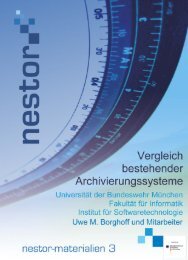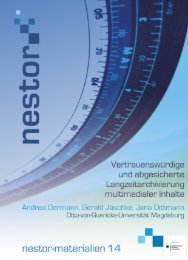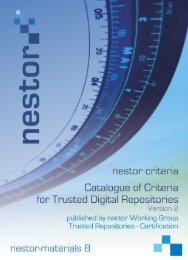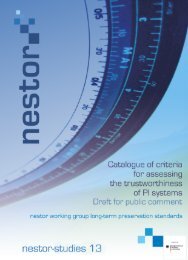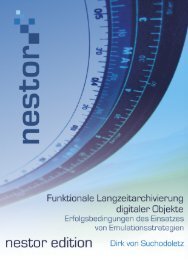One of the shortcomings of the software on which pedocs was originally based is itsinadequacy in identifying and representing the different kinds of relationships that mightexist between digital objects (a requirement explicitly voiced by the nestor criteria: see2008, 12.1), which can be expressed by means of structural or context metadata. Inorder to improve the current situation, pedocs is planning to make the hierarchical relationexisting between journal titles, issues, and the individual articles composing themtransparent with the help of a (metadata-based) browsing functionality. Thus it will becomepossible to browse journal titles and issues to access all related articles published inpedocs. These relations will be established via the journal title, volume, and issue. Furtherinformation about journal titles is also available by way of the recently implemented linksto the ZDB (Zeitschriftendatenbank). 97While the possibility to browse from an article to the journal (issue) and vice versamight primarily be a matter of convenience for users, the impossibility of establishingrelationships between different versions of an object has implications for long-termpreservation in that it might limit or prevent the effective use of the preserved object in thefuture. Currently, if a new version of an object is ingested into the repository, there is noway of linking these two versions, or of indicating conveniently that one replaces theother. 98 However, work is currently carried out by the pedocs team to implementversioning. Thus, it is planned to add a metadata field to records into which the ID of arelated document record can be entered. In addition, a field will exist in which the relationcan be further specified by means of Dublin Core (dc.relation and qualifiers).Example: The need for versioning in pedocsThe pedocs record with the ID 807 99 , which was already cited above, has two documents attachedto it; the second of these (Dokument 2.pdf) provides context and background information aboutthe first, which is the main document containing a study/synopsis of German elementary schoolcurricula in the subject “Sachkunde” between 1992 and 2009. In these preliminary remarks theauthor explicitly asks users to create updated versions of the main document as the curriculachange:Sollte festgestellt werden, dass Lehrpläne einzelner Länder nicht mehr aktuell sind, wird hierausdrücklich darum gebeten, aktuelle Daten individuell einzuarbeiten und die Synopse inpassender Weise zu ergänzen bzw. zu überarbeiten. Das dabei neu entstandene Dokumentsollte dann […] im Open Access Netzwerk als folgende Version eingestellt werden, mit einemHinweis auf die Aktualisierung […]. Da sich die Datenbank Pedocs bereit gestellt hat, alte undneue Version parallel zu veröffentlichen, wird dann möglich sein, die Veränderungen, die mitden neuen Lehrplänen einhergehen, nach zu verfolgen […]. (Efler-Mikat 2009, Dokument2.pdf, II)While currently it is difficult (if not impossible) for future users to conveniently find either later or97 http://dispatch.opac.d-nb.de/LNG=DU/DB=1.1/ – 31.10.2009.98 The question of what constitutes a new version of an already submitted (and, for example, hence warrantsthe creation of a new record with an URN assigned to it) is by no means easily answered. See Brace's“Versioning in Repositories” (2008) and the homepage of the Version Identification Framework (VIF)project (http://www.lse.ac.uk/library/vif/) for considerations about versions and version control inrepositories (see in particular http://www.lse.ac.uk/library/vif/Framework/SoftwareDevelopment/linking.htmlfor the issue of linking records and how it is addressed in DSpace, Fedora, and EPrints) – 03.11.2009. Thequestion of versions and editions of AIPs is also raised in the OAIS version 2 candidate, which nowcontains definitions of AIP Editions and AIP Versions (see OAIS 2009, 1-7).99 http://www.pedocs.de/volltexte/2009/807/ – 24.10.2009.36
previous versions of this document – especially, as different versions might not be published bythe same author – after the implementation of the changes described above, links will existbetween these documents which will facilitate navigation between versions.Additional context information, e.g. why the content object was produced, might becontained in the abstract in some cases but is not captured otherwise. In that such contextinformation can, in most cases, only be provided by the original author of a resource,there is no opportunity to add it at any later point (e.g. by the DNB).Rights metadata: All records contain a link to copyright information 100 , which isgenerally the same for all documents in the repository if not stated otherwise. Thecopyright information refers users to German copyright law (Urheberrechtsgesetz), whichamong others allows the printing and saving of documents for private or educational use.Additional rights metadata will only be added in the rare case of exceptions.As mentioned above, pedocs uses JHOVE to generate a small set of technicalmetadata based on format identification and validation. Thus, <strong>file</strong> format, format versionand checksum will be submitted to the DNB. At the DNB, a fuller set of technical and otherpreservation metadata will be generated and saved. Thus, the DNB has defined a set ofmetadata relevant to the preservation of digital objects (LMER – Long-term preservationMetadata for Electronic Resources) and will use this metadata in the preservation of thepedocs collection. Capable of being integrated into METS and working with links to formatregistries, the LMER metadata set comprises the following elements:lmerObject: This includes metadata that corporately refer to all sub-<strong>file</strong>s of the document. Italso comprises the URN as a Persistent Identifier to establish a unique reference to thebibliographic metadata.lmerProcess: Within these metadata, all technical changes to the object or to any <strong>file</strong> of theobject are recorded [...].lmerFile: For each <strong>file</strong> that belongs to the object, metadata describing its characteristics arestated here. These metadata are composed of general fields that are common to all <strong>file</strong> types,and of specific fields (e.g., the frame rate for videos) […].Metadata Modification: Within these metadata, all changes to the LMER metadatathemselves are recorded. (Die Deutsche Bibliothek 2005, 8)Where <strong>file</strong> type-specific metadata are required, these are added in lmerFile by mean of aspecial field (xmlData), which “has been assigned to assimilate any XML metadata inanother schema,” a “modular approach […] made possible by the namespace concept ofXML [...]” (Die Deutsche Bibliothek 2005, 5).Fixity information for the digital object(s) contained in the (pre-)AIPs produced bypedocs is generated in the form of checksums, which will be discussed below (seeArchival Storage).Ingest: Generate Descriptive Infopedocs currently supports three document types: Articles in a journal, essays in acollection, and monographs. The metadata for the different document types consists of a100http://www.pedocs.de/doku/urheberrecht.php?la=en – 03.11.2009.37
- Page 6: AbstractTaking its cue from the inc
- Page 13: and benefit from the development an
- Page 18 and 19: German repositories have already be
- Page 20 and 21: [t]he Open Archival Information Sys
- Page 22 and 23: Thus it seems highly recommendable
- Page 24 and 25: actively pursuing the long-term pre
- Page 26 and 27: Like pedocs, the repository is not
- Page 28 and 29: application for a project grant was
- Page 30 and 31: generating an Archival Information
- Page 32 and 33: Integrity can be defined as “comp
- Page 34 and 35: It is with this step that the metad
- Page 36 and 37: documents submitted to the reposito
- Page 38 and 39: [t]he majority of OCR software supp
- Page 42 and 43: set of shared metadata which is the
- Page 44 and 45: document, and that hence the docume
- Page 46: Structural metadata: In DSpace it i
- Page 49 and 50: dc.description.provenancedc.descrip
- Page 51 and 52: Für die Langzeitverfügbarkeit der
- Page 53 and 54: ecord for a title; although a workf
- Page 55 and 56: Source (where applicable)Publicatio
- Page 57 and 58: checksums. In particular, TRAC requ
- Page 59 and 60: checksums are currently not checked
- Page 61 and 62: 2.4.2 JUWEL Data ManagementThe stru
- Page 63 and 64: Before any SIPs are accepted, the r
- Page 65 and 66: guarantee that documents are “arc
- Page 67 and 68: pedocs is a scholarly open access d
- Page 69 and 70: formats. 151 Although the possible
- Page 71 and 72: While the preferred file format is
- Page 73 and 74: from nestor criterion 8, making it
- Page 75 and 76: preserved for the long term, will h
- Page 77 and 78: It seems that of all three reposito
- Page 79 and 80: associated with them, or has define
- Page 81 and 82: versioning functionality which allo
- Page 83 and 84: communication channels, responsibil
- Page 85 and 86: Works CitedAllinson, Julie (2006):
- Page 87 and 88: DSpace Homepage. http://www.dspace.
- Page 89 and 90: Lynch, Clifford A. (2000): Authenti
- Page 91 and 92:
in the EU. Amsterdam: Amsterdam Uni
- Page 93 and 94:
Ingestnestor TRAC DINIReceive Submi
- Page 95 and 96:
Archival Storagenestor TRAC DINIRec
- Page 97 and 98:
Archival Information Update10.4 Das
- Page 99 and 100:
Preservation PlanningnestorMonitor



